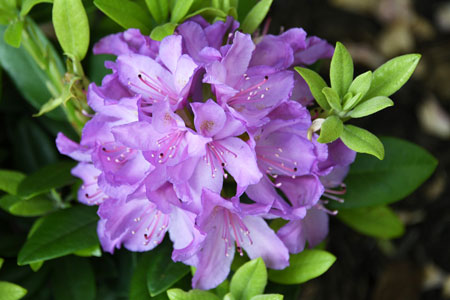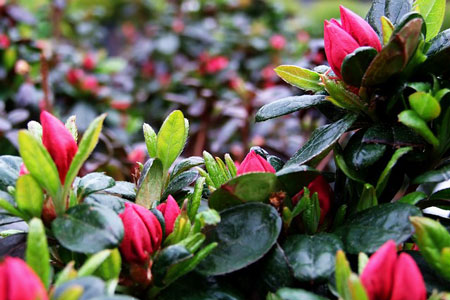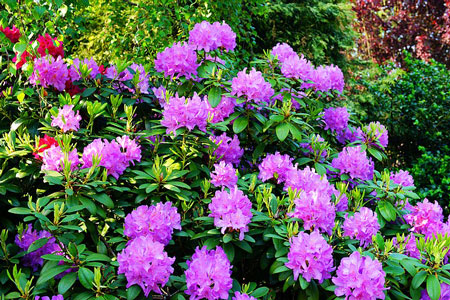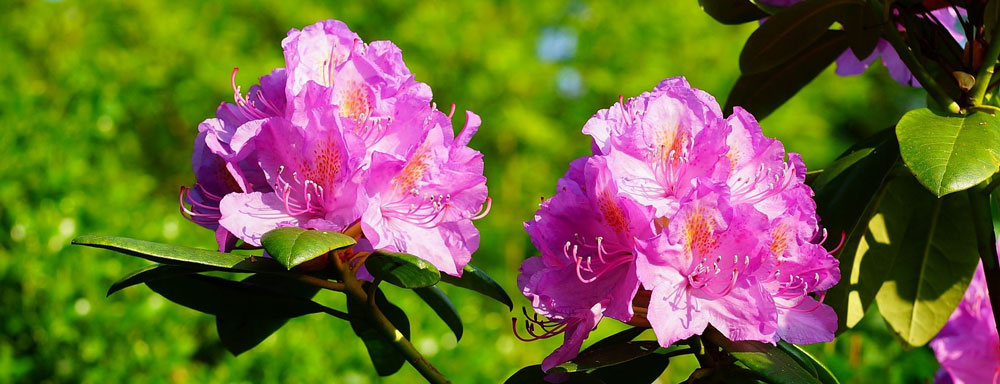Azaleas & Rhododendrons
Care for optimal growth
Azaleas and Rhododendrons are the most popular, decorative evergreen shrubs, with their vivid display of flowers from late winter to early summer. Blooms in many different forms and sizes including tubular, starry, bell and bowl shaped, large and small, and even fragrant. These are poisonous plants for consumption so don't let children or pets eat any part of them.
At a Glance:
- Height - 50cm to 4 metres
- Position - semi shade
- Soil - moist, lime free, well drained
- Flower - late winter to summer
- Colour - pink, white, red, yellow, cream, mauve, blue, purple, orange.

Selection
The difference between Rhododendrons and Azaleas is minute but worth noting. Azaleas belong to the Rhododendron genus but not all Rhododendrons are Azaleas.
Azaleas are deciduous, tending to have smaller leaves and maturing into smaller plants than other Rhododendrons. The flowers of the Azalea also have only five stamens whereas the other Rhododendrons have ten.
Rhododendrons:
- Evergreen and flower from late winter to early summer.
- Large and small flowered varieties.
- Grow from a height of 50cm to 4 metres.
- Modern varieties tend to reach only 2 metres.
Azaleas:
Azalea indica
- The best known evergreen azalea.
- Flowers from late winter to early summer, in coastal regions to cooler highlands.
- Large flowers, small leaves and grow from 60cm to 1.2 metres in height.
Kurume azaleas
- Evergreen with small leaves and small single or semi double flowers which smother the plant in spring.
- Tolerates cooler temperatures and requires less shade than indica varieties.
- Grow from 60cm to 1 metre in height
.
Mollis azaleas
- Deciduous, losing their leaves in winter.
- Flowers appear before the foliage in spring. Foliage is highly coloured in autumn.
- Prefers a cooler climate.
- Will grow in full sun to a height of 1.5 metres
- Some varieties are fragrant.
When to Plant
The best time to plant is from winter to early spring, before flowering. Azaleas and rhododendrons can be planted at any time as long as they are well watered through the summer months.
Where to Plant
- Plant in a moist well drained soil that has plenty of good compost (make sure the compost has no added lime in it) and organic material, dug in before planting. Raise beds in clay soil to improve drainage.
- Plant in shade to filtered sunlight. Some varieties will tolerate sun.
- Azaleas look great in mass plantings, mixed borders with other plants, in front of a background of evergreen shrubs or under deciduous trees.
- Rhododendrons are at their best planted in mixed borders, blending in well with many other plants
How to Plant
Before planting water the plant well. Dig in plenty of good compost (make sure the compost has no added lime in it) , well rotted animal manure or organic material to the planting hole.
Refer to the Nichol’s handy helper on "How to Plant Trees, Shrubs and Roses" for more information.

After Care …
Feeding
- Rhododendrons and azaleas do not require a lot of fertiliser.
- Apply sparingly as they have very shallow surface roots which can burn easily.
- Rhododendrons and Azaleas are acid lovers - i.e. they HATE LIME! So we recommend you apply Tui Acid Fertiliser in late winter and again in mid-summer.
Watering
Regular watering through summer is required. Deep watering is more effective than light sprinklings.
Mulching
This is essential for success!
Apply a 5cm thick layer of good compost (make sure the compost has no added lime in it) or mulch around azaleas and rhododendrons in late winter and again in mid summer to ensure roots stay cool and moist.
Pruning
- Regular pruning is not required, however, sometimes they will benefit from being cut back.
- A spindly young rhododendron can be cut back by one third of its length, above a bud, in late winter early spring.
- Pinch young shoot tips to encourage bushy growth.
Pests and Diseases
Thrips are small black sucking insects that cause speckled silvery leaves. Spray with Mavrik.
Mites are minute sucking insects found on the underside of leaves that cause distortion, speckling and silvering of leaves. Spray with Mavrik.
Aphids are small sucking insects on new growth. Control with Pyrethrum.
Leaf Roller Caterpillars chew holes in leafs and flowers and roll themselves up in the leaves with webbing. Squash the caterpillar with fingers, or spray with Yates Success.
Powdery Mildew makes the leaves generally appear smaller, off-colour and the underside of the leaves are covered in a powdery like substance. Try to improve air circulation around the plant. Spray with Yates Natures Way Fungus Spray.
Alkaline Soil If the soil is too alkaline yellow patches appear between the veins. Use Tui Acid Food to correct this.

12071